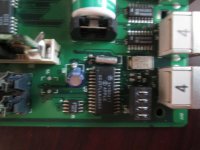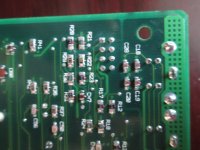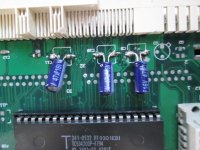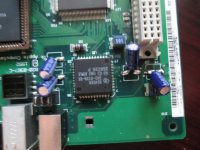agent_js03
Well-known member
Hey everyone!
Major update.
Late this morning I had a free moment so I desoldered the tantalum capacitors and removed them since they were soldered on so badly. I then proceeded to solder on some electrolytic "tin can" capacitors instead, which were a breeze to solder on compared to the tiny tantalum ones.
I also did the patch that bibilit posted about earlier, even though I didn't think it would be necessary.
I plugged it in, switched it on, and pressed the power key. Nothing happened.
I was feeling disappointed when I did remember something that I read about in another forum. It is generally not recommended (I mentioned it earlier in this thread) but since I had nothing left to lose, I gave it a try. I unplugged my motherboard, turned the classic on, and then plugged the motherboard in. In the past, this either did nothing, or just caused the floppy drive to turn over and over. This time, I got a chime, a grey screen, and the happy mac logo, and then the little mac proceeded to boot all the way up!
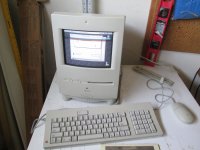
Naturally, this was very exciting. Up till now I haven't gotten anything from this little machine. Now I had a fully booted up working machine. Sound worked and everything. Runs Mac os 7.5.3. Whoever owned this machine before must have been in the multimedia business because it is loaded with all kinds of graphics and sound software; photoshop, Infini-D 3D graphics software, sound/midi software, the works. I played some of the composed midi files on the speaker and it worked perfectly.
So it seems that the motherboard works and everything works, the only thing that doesn't work is booting from the keyboard. I have used this keyboard with other macs and have booted from it, so I am pretty sure it works. I am at a loss as to what could be causing this to not work properly. Is anyone knowledgeable enough about the circuitry in this device that could tell me what part is involved in this? Could it be something on the analog board?
Major update.
Late this morning I had a free moment so I desoldered the tantalum capacitors and removed them since they were soldered on so badly. I then proceeded to solder on some electrolytic "tin can" capacitors instead, which were a breeze to solder on compared to the tiny tantalum ones.
I also did the patch that bibilit posted about earlier, even though I didn't think it would be necessary.
I plugged it in, switched it on, and pressed the power key. Nothing happened.
I was feeling disappointed when I did remember something that I read about in another forum. It is generally not recommended (I mentioned it earlier in this thread) but since I had nothing left to lose, I gave it a try. I unplugged my motherboard, turned the classic on, and then plugged the motherboard in. In the past, this either did nothing, or just caused the floppy drive to turn over and over. This time, I got a chime, a grey screen, and the happy mac logo, and then the little mac proceeded to boot all the way up!

Naturally, this was very exciting. Up till now I haven't gotten anything from this little machine. Now I had a fully booted up working machine. Sound worked and everything. Runs Mac os 7.5.3. Whoever owned this machine before must have been in the multimedia business because it is loaded with all kinds of graphics and sound software; photoshop, Infini-D 3D graphics software, sound/midi software, the works. I played some of the composed midi files on the speaker and it worked perfectly.
So it seems that the motherboard works and everything works, the only thing that doesn't work is booting from the keyboard. I have used this keyboard with other macs and have booted from it, so I am pretty sure it works. I am at a loss as to what could be causing this to not work properly. Is anyone knowledgeable enough about the circuitry in this device that could tell me what part is involved in this? Could it be something on the analog board?

